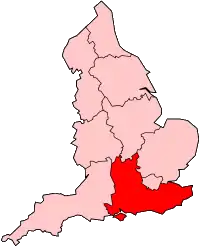Tattenham Corner line
The Tattenham Corner line is a railway line in Southern England that runs between Purley in South London and Tattenham Corner in Surrey.
| Tattenham Corner line | |
|---|---|
 A 1905 Railway Clearing House map of the Tattenham Corner line and surrounding lines | |
| Overview | |
| Status | Operational |
| Owner | Network Rail |
| Locale | Greater London Surrey |
| Termini | London Bridge London Victoria Tattenham Corner |
| Service | |
| Type | Commuter rail, Suburban rail |
| System | National Rail |
| Operator(s) | Southern |
| Rolling stock | Class 377 "Electrostar" Class 455 |
| History | |
| Opened | 2 November 1897 |
| Technical | |
| Track gauge | 1,435 mm (4 ft 8 1⁄2 in) standard gauge |
| Electrification | 750 V DC third rail |
Tattenham Corner line | ||||||||||||||||||||||||||||||||||||||||||||||||||||||||||||||||||||||||||||||||||||||||||||||||||||||||||||||||||||||||||||||||||
|---|---|---|---|---|---|---|---|---|---|---|---|---|---|---|---|---|---|---|---|---|---|---|---|---|---|---|---|---|---|---|---|---|---|---|---|---|---|---|---|---|---|---|---|---|---|---|---|---|---|---|---|---|---|---|---|---|---|---|---|---|---|---|---|---|---|---|---|---|---|---|---|---|---|---|---|---|---|---|---|---|---|---|---|---|---|---|---|---|---|---|---|---|---|---|---|---|---|---|---|---|---|---|---|---|---|---|---|---|---|---|---|---|---|---|---|---|---|---|---|---|---|---|---|---|---|---|---|---|---|---|
| ||||||||||||||||||||||||||||||||||||||||||||||||||||||||||||||||||||||||||||||||||||||||||||||||||||||||||||||||||||||||||||||||||
Mileage measured from London Charing Cross | ||||||||||||||||||||||||||||||||||||||||||||||||||||||||||||||||||||||||||||||||||||||||||||||||||||||||||||||||||||||||||||||||||
History
The line was opened in two parts. The first stage was built from Purley as far as Kingswood as the Chipstead Valley Railway. Local MP and Chairman of the South Eastern Railway at the time, Sir Cosmo Bonsor proposed the line in 1893.[1] However, given the difficult terrain of the route which would have involved deep cuttings and tight bends, the idea was met by some opposition from his fellow directors. Despite this, construction eventually began in 1896 and on 2 November 1897 a single-track line to Kingswood (originally Kingswood and Burgh Heath[2]) was complete.[3]
In 1899 Sir Cosmo Bonsor formed a private syndicate to have the line extended from Kingswood to its current terminus at Tattenham Corner in order to catch the racegoing traffic.[4] By Derby Day on 4 June 1901, the extension to Tattenham Corner was opened, during which time the line was also upgraded from single to double track.[5]
The Chief Engineer to the Chipstead Valley Railway was Lt Col Arthur John Barry.[6]
The line was third rail electrified by Southern Railway at 660 V DC in March 1928, and later upgraded to 750 V DC by British Rail post-war. The line is now part of the Thameslink, Southern and Great Northern franchise.
In May 2011 Smitham station was officially renamed Coulsdon Town, following a public vote on a new name for the station.
Route
The line diverges eastwards from the Brighton Main Line at Purley. It immediately splits from the Caterham Line and passes below the Brighton line. It then runs close to the Brighton line as far as Coulsdon Town, after which it turns westwards and follows the Chipstead Valley, eventually climbing to the high ground at Tattenham Corner.
The line is primarily a commuter route, but the station at Tattenham Corner was built to serve the Epsom Downs Racecourse, with large numbers of extra trains for The Derby on Derby day. There is also a railway terminus at Epsom Downs, about 2 km north of the racecourse, which was built by the London, Brighton and South Coast Railway and opened on 22 May 1865.
Oyster and contactless payment cards are valid for travel on the entire length of the route. The line from Purley to Tattenham Corner is located entirely within Travelcard Zone 6.
Services
Train services on the line are operated by Southern
There is an all day Monday-Saturday service to London Bridge, calling at all stations to East Croydon, then fast to London Bridge. These trains combine/divide at Purley, the other section being for the Caterham Line. At peak times, there are additional services to Victoria. On Sundays, these trains additionally call at all stations via Sydenham.
In off peak times Monday-Saturday, since May 2018, a service runs from Coulsdon Town to London Bridge calling at all stations via Sydenham
Almost all services from Tattenham Corner are provided by 5-car Class 377 EMUs. The services on the Coulsdon Town to London Bridge via Sydenham route are run by 8-car Class 455 trains on weekdays.
The London and South East Route Utilisation Strategy released in July 2011 laid out a provisional timetable for the Thameslink Programme. Services 'assumed to operate through the Thameslink core in 2018' featured an eight-car Tattenham Corner to Welwyn Garden City service.[7] This did not materialise.
In December 2013 the old sidings at Tattenham Corner were reinstated to support overnight storage of some of the new trains ordered since 2011, as part of the train-lengthening process.[8]
References
- Chipstead Village Surrey (2012). "Tattenham Corner Railway". chipsteadvillage.org. Retrieved 2012-02-25.
- Southern e-group (2012). "Stations - K". semgonline.com. Retrieved 2012-02-25.
- John Speller (2012). "Chipstead Valley Railway". spellerweb.net. Retrieved 2012-02-25.
- BBC R&D (2012). "BBC Kingswood Warren". bbc.co.uk. Retrieved 2012-02-25.
- Adrian Wymann (2007). "Epsom Downs Branch - Early History (1865 - 1928)". Wymann.info. Retrieved 2007-04-18.
- Frederick Arthur Crisp Visitation of England and Wales, Volume 14, London (1906)
- London and South East Route Utilisation Strategy page 72
- Foster, Alice (7 November 2013). "Plans to cut silver birches beside railway line come under fire in Tattenham Corner". Your Local Guardian. Retrieved 18 March 2016.
Further reading
- Mitchell, Victor E.; Smith, Keith (January 1994). Caterham and Tattenham Corner. London Suburban Railways. Midhurst: Middleton Press. figures 54–120. ISBN 1-873793-25-1.
- Moody, G.T. (1979). Southern Electric 1909-1979. Ian Allan. ISBN 0-7110-0924-4.
- Glover, John (2001). Southern Electric. Ian Allan. ISBN 0-7110-2807-9.

